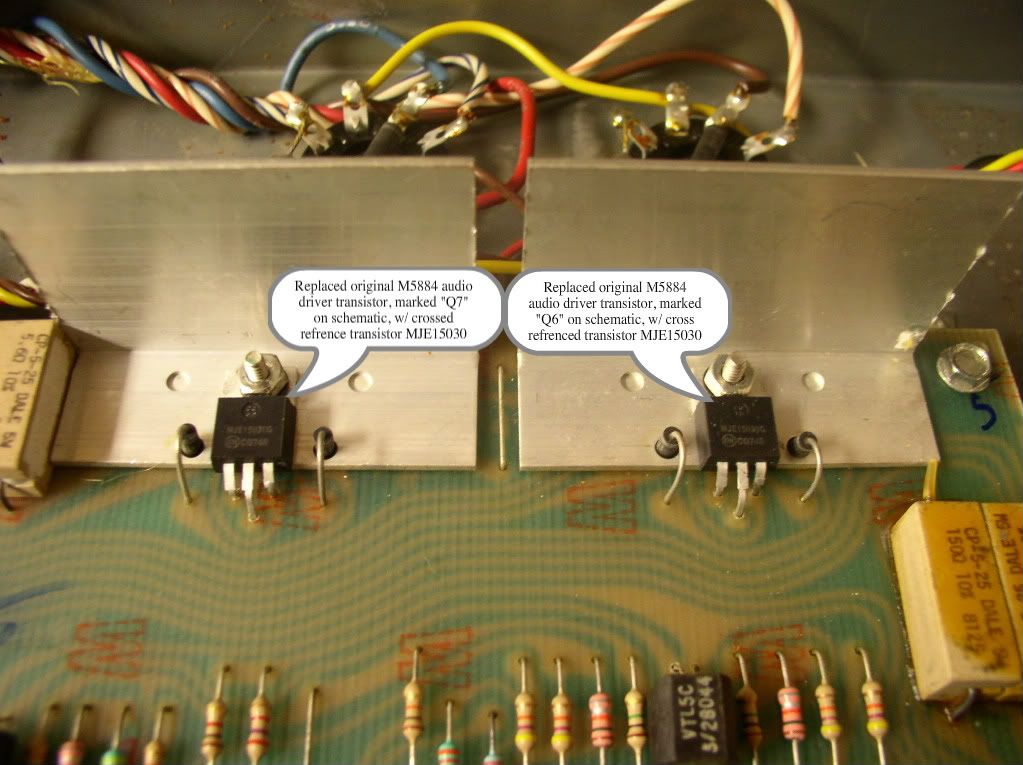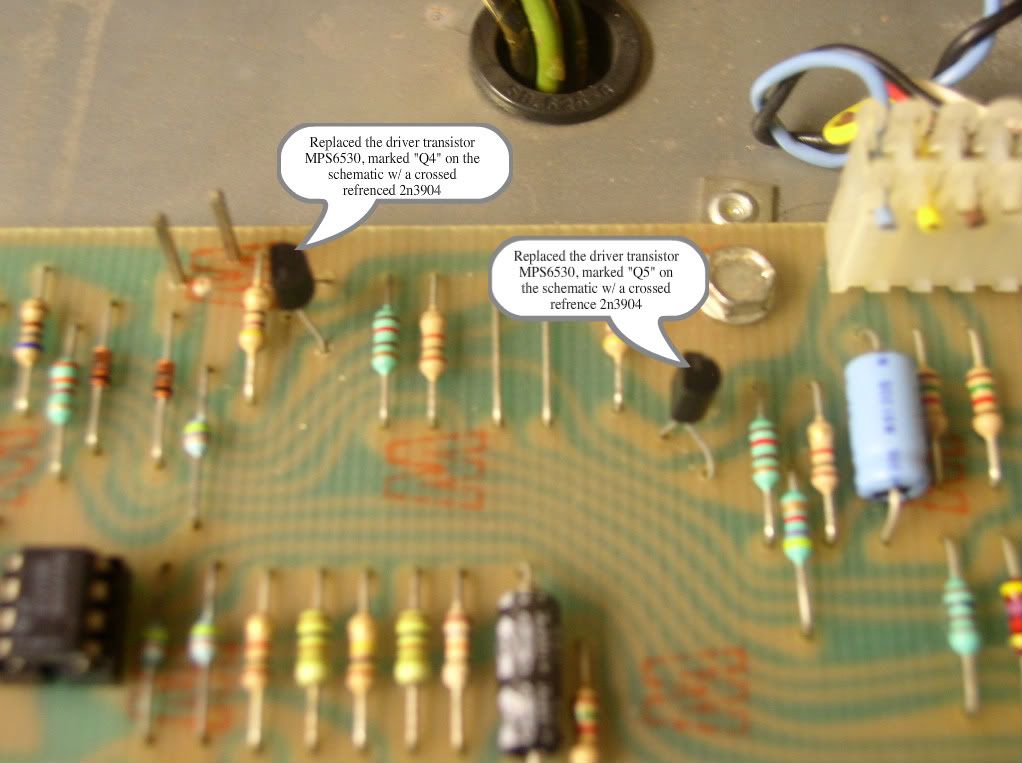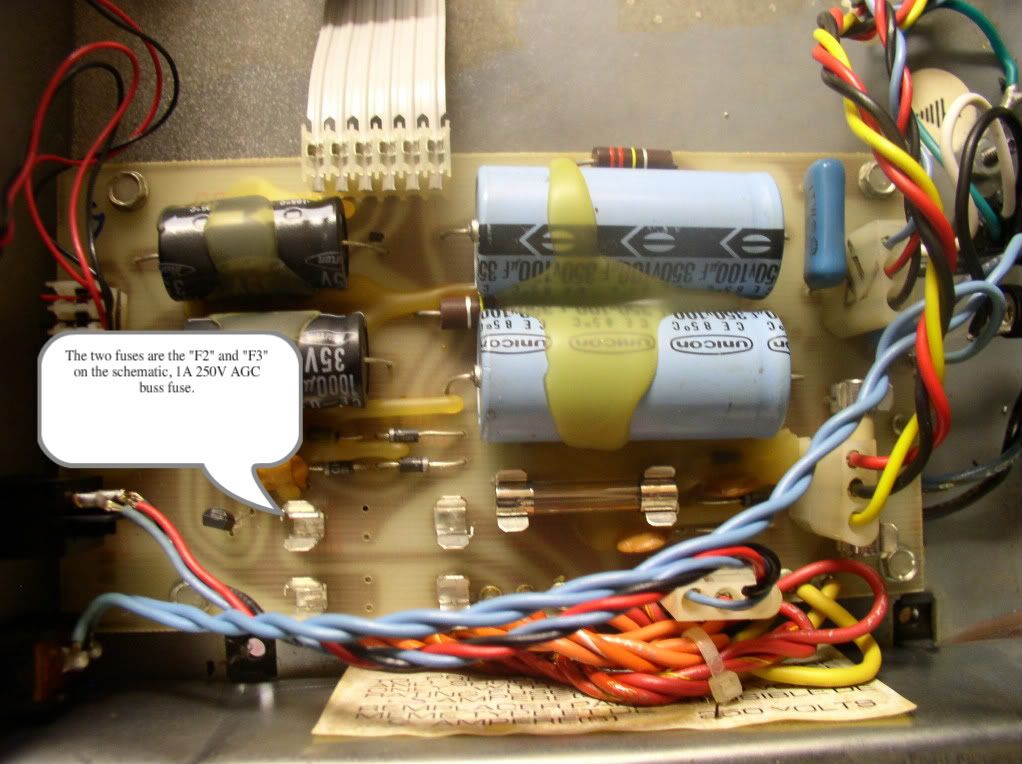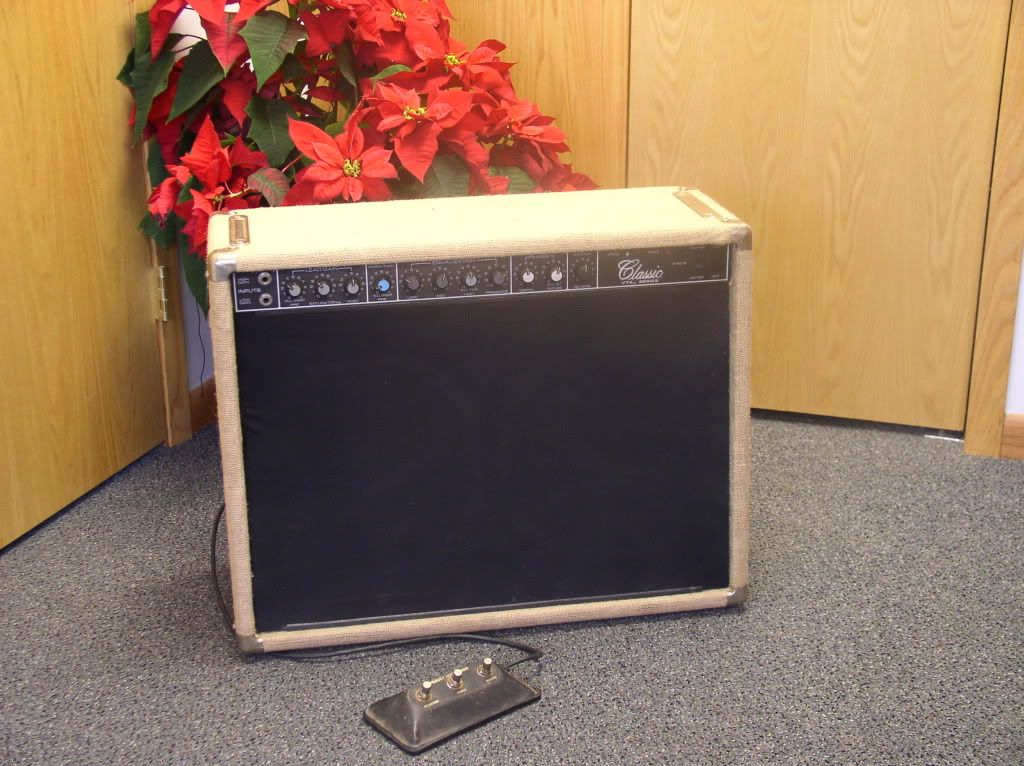Hello to all,
Recently I had picked up a Peavey classic vtx series combo out of a storage unit, it was sitting in the corner rotting away with the ages and had caught my eyes as most musically driven items do. What also helped was the re-cover job-(burlap and staples) - with grim results, that led me to want to save this amp. So, I dug her out- FS and all and took her on home.

Upon a thorough external exam, everything seemed to be intact- Power tubes, Reverb pan, the FS was in fair to poor condition, had all its knobs and the pots where a little stiff. External fuse was good and intact. Power cord was missing its ground prong and slightly frayed. Speaker jack was in good shape and the speakers seemed to look ok, except some age. We all know about looks- there deceiving. So, I proceed w/ plugging it in and powering it up accordingly- everything is in check- status led’s are working , no cracks or pops, funny smells, tubes are operating good from visual inspection- glowing evenly and not operating overly hot. So, I plug in the guitar and turn the standby switch. Wow, what a bummer- very weak low volume w/ a hissing/buzz. Everything is still in working properly just there is no great sound coming from this thing as I have read these things are pretty perky when working correctly. Frustration gets the better of me for a bit, and it is retired to the GARAGE!!!!
Few days later I decide to pull it out of the COLD garage, let it warm up for a few hours, throw some newer 6L6’s in her I had lying around, power up accordingly, and “damN” She was off to the races, nice and loud at reasonably low settings, full of tone variations, the FS was even working considering the shape it was in. Everything seemed fine- Then in the middle of our new found love affair, she turns and walks away, back to the comfy confines of her previous state- low volume w/ a hissing buzz!!! Thinking of course, swapping the tubes with some old ones I had laying around was the fix last time, I ran out to buy some new tubes to see if this would be the fix. Nope, same story w/ the new tubes. So, I proceed to plug directly into the back of the chassis to the “power amp in” jack. The power amp works remarkably well, although there is no volume control (normal, there is no preamp control- it’s bypassed). It sounds ok, and I spent a minute playing through it this way. “Power amp is fine”!!! Next, what I do know is that the preamp out and the power amp in jack are wired together in a relay of sorts, so to see if the connection was bad between the jacks internally, I connected them externally w/ a ¼” 90deg. Patch cord. Still the same result- Low volume w/ a hissing/buzz! That leaves me with no other option but to break her down and get it up the bench. I start this as I do any other rebuild or repair- An extensive research campaign, finding any and all info. I can about this particular amp. – Schematics, Calls to Peavey, Forums, Internet, Books, Astrological Signs and Moon Beam Deflection- Kidding!! Upon some learning a little more of this amp., I begin an internal examination of the chassis, pcb’s, wires ,internal fuses, solder contacts- everything seems to be fairly clean and in good shape no funny smells, bulging caps, fried wires . Clean it all up, flushed pots, cleaned pcb w/ board cleaner, cleaned some contacts, and replaced the a/c line cord with an exact gauge match that had a ground prong. Reassembled, same as before powering up and still the same results. Low volume w/ a hissing/ buzz.
So, I proceed to take some of a fellow owner of the same amps advice with the same symptoms and some suggestions from peavey to try and correct these problems.
First, I replaced the audio driver transistors located on top of the heat sinks on the pre-amp board.Here are some pics of the new transistors in place.

Second, I replaced the driver transistors, Here are some pics of the new transistors in place.

Fairly easy replacements, I have a bit of experience w/ PCB’s and the soldering was perfect on theserepairs,hard to locate they blend in w/ the factory contacts. Gave it a good examination to make sure everything was correct and reassembled, and began the precursory fire up and “BOOM” I’m blowing internal fuses now!
Here are some pics of the power board and the fuses that are blowing.

The amp will remain on and the power led will start from nothing and increasingly get brighter to a degree, the standby led doesn’t work at all, all other fuses are ok, and the tubes are seemingly ok-not overly bright, overly hot, no strange arcs or pops other than the two internal fuses.
I have a few ideas as to what it might be but was interested in some feedback and possible help narrowing it down. Or, quite possibly I could have overlooked something or done something wrong. I am fairly new to the Amp. Tech world itself, but have some experience and am aware of the dangers and how to avoid them. Feel free to school me on the knowledge and the no-no’s, after all any help would be appreciated. Thanks and happy holidays!!!
Brian
I also have a bunch of other pics of this amp!!!!!
Recently I had picked up a Peavey classic vtx series combo out of a storage unit, it was sitting in the corner rotting away with the ages and had caught my eyes as most musically driven items do. What also helped was the re-cover job-(burlap and staples) - with grim results, that led me to want to save this amp. So, I dug her out- FS and all and took her on home.

Upon a thorough external exam, everything seemed to be intact- Power tubes, Reverb pan, the FS was in fair to poor condition, had all its knobs and the pots where a little stiff. External fuse was good and intact. Power cord was missing its ground prong and slightly frayed. Speaker jack was in good shape and the speakers seemed to look ok, except some age. We all know about looks- there deceiving. So, I proceed w/ plugging it in and powering it up accordingly- everything is in check- status led’s are working , no cracks or pops, funny smells, tubes are operating good from visual inspection- glowing evenly and not operating overly hot. So, I plug in the guitar and turn the standby switch. Wow, what a bummer- very weak low volume w/ a hissing/buzz. Everything is still in working properly just there is no great sound coming from this thing as I have read these things are pretty perky when working correctly. Frustration gets the better of me for a bit, and it is retired to the GARAGE!!!!
Few days later I decide to pull it out of the COLD garage, let it warm up for a few hours, throw some newer 6L6’s in her I had lying around, power up accordingly, and “damN” She was off to the races, nice and loud at reasonably low settings, full of tone variations, the FS was even working considering the shape it was in. Everything seemed fine- Then in the middle of our new found love affair, she turns and walks away, back to the comfy confines of her previous state- low volume w/ a hissing buzz!!! Thinking of course, swapping the tubes with some old ones I had laying around was the fix last time, I ran out to buy some new tubes to see if this would be the fix. Nope, same story w/ the new tubes. So, I proceed to plug directly into the back of the chassis to the “power amp in” jack. The power amp works remarkably well, although there is no volume control (normal, there is no preamp control- it’s bypassed). It sounds ok, and I spent a minute playing through it this way. “Power amp is fine”!!! Next, what I do know is that the preamp out and the power amp in jack are wired together in a relay of sorts, so to see if the connection was bad between the jacks internally, I connected them externally w/ a ¼” 90deg. Patch cord. Still the same result- Low volume w/ a hissing/buzz! That leaves me with no other option but to break her down and get it up the bench. I start this as I do any other rebuild or repair- An extensive research campaign, finding any and all info. I can about this particular amp. – Schematics, Calls to Peavey, Forums, Internet, Books, Astrological Signs and Moon Beam Deflection- Kidding!! Upon some learning a little more of this amp., I begin an internal examination of the chassis, pcb’s, wires ,internal fuses, solder contacts- everything seems to be fairly clean and in good shape no funny smells, bulging caps, fried wires . Clean it all up, flushed pots, cleaned pcb w/ board cleaner, cleaned some contacts, and replaced the a/c line cord with an exact gauge match that had a ground prong. Reassembled, same as before powering up and still the same results. Low volume w/ a hissing/ buzz.
So, I proceed to take some of a fellow owner of the same amps advice with the same symptoms and some suggestions from peavey to try and correct these problems.
First, I replaced the audio driver transistors located on top of the heat sinks on the pre-amp board.Here are some pics of the new transistors in place.

Second, I replaced the driver transistors, Here are some pics of the new transistors in place.

Fairly easy replacements, I have a bit of experience w/ PCB’s and the soldering was perfect on theserepairs,hard to locate they blend in w/ the factory contacts. Gave it a good examination to make sure everything was correct and reassembled, and began the precursory fire up and “BOOM” I’m blowing internal fuses now!
Here are some pics of the power board and the fuses that are blowing.

The amp will remain on and the power led will start from nothing and increasingly get brighter to a degree, the standby led doesn’t work at all, all other fuses are ok, and the tubes are seemingly ok-not overly bright, overly hot, no strange arcs or pops other than the two internal fuses.
I have a few ideas as to what it might be but was interested in some feedback and possible help narrowing it down. Or, quite possibly I could have overlooked something or done something wrong. I am fairly new to the Amp. Tech world itself, but have some experience and am aware of the dangers and how to avoid them. Feel free to school me on the knowledge and the no-no’s, after all any help would be appreciated. Thanks and happy holidays!!!
Brian
I also have a bunch of other pics of this amp!!!!!
 [/IMG]
[/IMG]
Comment